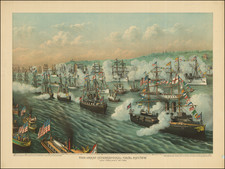Published in Amsterdam in 1720, the engraving De inbeelding, heersseres van 't rookverkopers-gild, maald Missisippi hier 't geen vrankryks schat verspild originates from the Mirror of Folly, a collection satirizing the financial speculation of the time. Within an oval frame at the top, the engraving features an image of a woman painting a scene of a square-rigged ship sailing off to "Missisippi," accompanied by various allegorical scenes and a Dutch poem that reflects on the Mississippi Bubble and the foolishness of speculative investments.
The inclusion of this engraving in the Mirror of Folly places it within the historical context of the early 18th-century financial crises, particularly the Mississippi Bubble. The disastrous speculation in shares of the Mississippi Company, led by Scottish financier John Law, resulted in a financial collapse that affected many investors in France and beyond. The allegorical imagery within the engraving, including the ship sailing to Mississippi, captures the illusion and folly of speculative endeavors.
The poem below the image, written in archaic Dutch, conveys a cautionary message about the impermanence of wealth and the fleeting nature of speculative investment. Through metaphor and allegory, it emphasizes the illusory nature of the riches promised by the Mississippi scheme, likening it to children's play with bubbles, destined to burst. The poem's reference to the "windrig Actie rot" (windy action rabble) reflects the widespread disillusionment and frustration with the speculative mania of the time.
The artistic and literary combination of this engraving is a powerful indictment of a specific historical moment. By intertwining visual and poetic elements, it provides an insightful commentary on the human propensity for greed and the transient nature of wealth. Its allegorical imagery and poetic language transcend the specifics of the Mississippi Bubble, offering a timeless reflection on the folly of financial speculation.
This engraving is not merely a historical artifact but an artistic and literary work that encapsulates the social and financial zeitgeist of its time. Through its skillful use of symbolism, allegory, and satire, it paints a vivid picture of human folly, ambition, and disillusionment. Its resonance with contemporary financial phenomena makes it a significant cultural document that transcends its historical context, reflecting on themes that continue to be relevant in the understanding of economic behavior and the human condition.









![[Title page -- Book of Martyrs] Acts and Monuments of Matters Most speciall and memorable, happening in the Church, with an universall Historie of same . . . 1632](https://storage.googleapis.com/raremaps/img/small/79484.jpg)
![[Dallas / Kennedy Assassination] La Mappa Dell'Odio](https://storage.googleapis.com/raremaps/img/small/89006.jpg)
![(South Sea Bubble) De Zuid Zé Compagnie Door Wind In Top Gerezen Beklaagt nu Haar Verlies Met Een Bekommerd Wezen. [The South Sea Company, once risen high by the wind, now laments its loss with a troubled countenance.]](https://storage.googleapis.com/raremaps/img/small/96219.jpg)
![[Surf's Up and Down!]](https://storage.googleapis.com/raremaps/img/small/76816.jpg)

![[ Passport of Lemuel B. Norton ]](https://storage.googleapis.com/raremaps/img/small/48456.jpg)